Who Uses IDC Financial Publishing’s Ranks and Why?
When financial markets became increasingly influenced by excessive lending before the financial crisis in 2018-2019, IDC Financial Publishing's methodology played an important role in tracking financial institution safety, and established a successful record that may alert investors to another period of risk in the future.
Learn how IDCFP became a benchmark with which to forecast a future financial crisis. Download a copy of IDC Financial Publishing’s, How to Predict a Financial Crisis to read more about our unique set of ratios used to measure the safety and soundness of a bank.
Our Customers
Many institutions rely on IDC Financial Publishing (IDCFP) CAMEL rankings to do business. This includes financial institutions that buy and sell brokered CDs, insurance companies, state and local governments, federal agencies, private companies, as well as individual banks, savings institutions, and credit unions.
Brokers trading certificates of deposit, registered investment advisors buying CDs, and firms assisting financial institutions in raising deposits. They all use our CAMEL ranks to assess the quality of banks issuing brokered CDs. State and local governments, determining the amount of assets to secure their bank deposits, rely on our rating services to measure the safety and soundness of financial institutions. Federal agencies use IDCFP ranks to determine credit worthiness. Private companies selling products to financial institutions determine potential for risk by using our institution ratings. Finally, individual banks, savings institutions and credit unions rely on our CAMEL analysis when evaluating their own strength, as well as for inter-bank lending.
The financial ratios used in IDCFP ranks were utilized in education for many years. Dr. David Cole, Professor Emeritus of Finance from the Fisher College of Business at the Ohio State University, incorporated IDCFP’s NOPAT ROE analysis as part of his instruction at the Pacific Coast Banking School (PCBS), which was utilized in the summer 2019 session. Dr Cole presented our unique calculations for return on earning assets (ROEA) and return on financial leverage (ROFL), the two components of our NOPAT ROE, or Net Operating Profit (After Tax) Return on Equity. He compared the traditional profit model of return on average assets and return on stockholder’s equity to the components of IDCFP’s NOPAT ROE, demonstrating our unique measurement of successful operating and profitable financial management.
Our Rating Standard
We calculate a one-number summary rank, based on an analysis of 24 financial ratios. Ratings range from 1, the lowest, to 300, the top grade attainable. The result is a quick, at-a-glance financial strength assessment that promotes direct and straightforward comparisons between any bank, savings institution, or credit union.
The IDCFP database gives you the ability to determine why things are going well...or not so well, offering an early forecast to help you plan. For those looking for more than a rating, we also provide the financial ratios used to calculate a rank number, as well as their weight. These ratios explain the financial institution's strengths and weaknesses and ultimately their impact on the final rank.
As a bank rating service, our financial experts also provide a unique comparison of subsidiary bank ratings, which we list with the parent holding company and its rank. This allows the subscriber to view the quality and strength of the parent holding company relative to the bank subsidiaries.
A leading long terms underwriter and trader of brokered CDs said "The IDC numeric rating system has been the Brokered Certificate of Deposit market’s benchmark for ranking credit quality for many years. By utilizing IDC’s CAMEL analysis and easy to understand rating we are able to make quick pricing decisions for our bank issuer customers."
Our Remarkable Track Record
In the early 1990’s, and again in the banking crisis of 2008-2009, institutions using IDCFP CAMEL ranks determined that ratings lower than 125 were deemed below investment grade. For example, buyers or holders of brokered CDs required a rank of 125 or higher for an issuing bank.
The Washington Department of Financial Institutions has stated directly on their website, “IDC has a remarkable track record of identifying deteriorating or improving performance months, and sometimes years before it becomes apparent to other ranking companies.” From 1990 to 2018, there were 1,419 failures of banks. Of these, 90% (1,272 banks) were ranked less than 125 by IDCFP up to 17 months before failure. Further, 73%, (1,033 banks) were rated less than 125 up to 29 months before a collapse.
Our Online Portal Features
Bank, savings institution, and credit union safety ratings and supporting financial ratios are all accessible through our online portal. The portal contains several features to access rating history for a single bank or group of institutions. Users have the option to search by CD CUSIP number, by institution name, or by location, and can sort by peer groups or by region of the country.
Purchase a user subscription plan for only what you need. Create customized Watch Lists to quickly and easily monitor only those institutions important to you or your organization.
Specialized Services
IDCFP also offers specialized rating services to subscribers and access to our qualified analysts when questions arise concerning ratings or methodology. The subscriber may know of unique circumstances for an institution that are not reflected in the standard regulatory reporting, conditions which could change the financial ratios and rating of the institution in that situation.
To view all IDCFP’s products and services, visit our website at www.idcfp.com. For further information, or for a copy of this article, please contact us at 800-525-5457 or info@idcfp.com.
John E Rickmeier, CFA, President, jer@idcfp.com
Robin Rickmeier, Marketing Director
